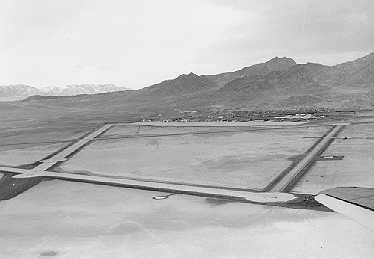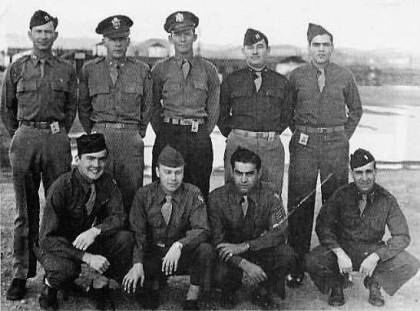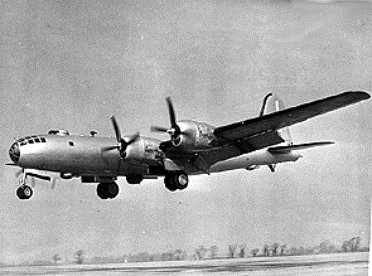THE 393rd BOMB SQUADRON

Wendover, Utah
Crew "Straight Flush"; Kneeling L to R: Sgt. Jack Bivans - Asst. Engineer; Sgt. Gillen Nicely - Tail Gunner; Sgt. Pasquale Baldasaro - Radio Operator; Lt. Eugene Grennan - Flight Engineer. Standing L to R: Maj. Claude Eatherly - Aircraft Commander; Lt. Ira Weatherly - CoPilot; Lt. Frank Wey - Bombardier; Capt. Francis Thornhill - Navigator; and, Sgt. Albert Barsumian - Radar Operator



I met my girlfriend, Pat - Patricia Rae Law just before I went to the service on December the 26th of 1943. I met her at a party and we started dating and then of course, not long after, I went into the service and we corresponded during all that time. Once I got a furlough of a couple of weeks and saw her. And I had a picture of her right in front of where I sat inside of my plane.
True to their word, approximately sixth months after my 18th birthday, which occurred at the end of August, I got called into active duty and was sent to the Air Cadet basic training program in Miami Beach. But I never did make it. They took forty thousand Air Cadets and put them in the infantry; they didn't need any more pilots by the time my turn came. But because I had enlisted in the Air Force, they couldn't ship me out; I was there! But instead of sending me to pilot school, they sent me to gunnery school and I became a gunner. And I first flew in B-17s, then in B-24s and finally they sent me to B-29 gunnery school. It was the biggest bomber around. I got into the 393rd Bomb Squadron and we were due to go overseas after about 13 weeks.
We were going end up in the South Pacific somewhere and bomb Japan. And one day they said, "The 393rd Bomb Squadron is going to report to Wendover, Utah." And we thought, "What in the world's going on?" We were not at all on our way to Japan; we were on our way to Utah. So we went out to Utah and the group commander was a fellow by of name Paul Tibbets. He called a meeting for all of us, several hundred of us, and said, "What we do here, what you learn here, may shorten the war by a couple of years - maybe a little bit longer. But you cannot talk about what you see when you leave here. And if you do, that will be reason for your dismissal." And that's all he said. So there was some big hub bub about what the secret was.
So we rehearsed. Rehearse is an actor's word - we trained - that's the right word - we trained for months flying over the desert. Salt Lake City, Utah, the better known of the cities, is a hundred and twenty-seven miles east of Wendover, Utah, where I was stationed. There were miles and miles - as far as the eye could see - of salt flats. The Bonneville Salt Flats, they call it - and they painted bull's eyes on these big salt flats, like you'd shoot at for a target. And it was our job to go up to 30,000 feet in our B-29 and see how accurate the bombardier was by dropping a bomb on the target below in the middle of the salt flats. Then they would go out and measure how well each plane did, how well that plane did, how well did Jack's plane do? How well did Jack's bombardier hit that target? And he was very good. His name was Ken Way - a very good bombardier. My pilot was crazy. He was a good pilot, but he was also nuts. For example, one time we were up there on a practice mission and he looked down below and I could hear him on the intercom say to the navigator, "Felix, is that the girls? Are they on their way into Salt Lake City?" Now, he meant Felix's wife and his wife; the two wives were driving a car into Salt Lake City. And Eatherly spots them from 30,000 feet above. Well, there was only a two-lane highway and no traffic. And Felix says, "Yes, that's them, Buck" - meaning Eatherly. He says, "Let's scare 'em." So he dive bombs that plane from 30,000 feet right at that car that the two of them are in and almost drove them off the road. And he pulled the plane up, just to give them a, "Hello, I see you." Another time he was getting bored - we were all getting bored; we hadn't gone overseas and we were in training so much and we couldn't figure out why. So he said to Kenny, the bombardier, "let's dive bomb this target today." You're supposed to just fly at 30,000 thousand feet level and drop the bomb. So instead of doing that, he aims the plane at the target straight down and dive, dive, dive, dive and at the last second he pulls out. He's not supposed to do this. As he pulled out, the tail hit the salt flats. When we landed back in Wendover, Utah fifteen minutes later, he jumped out of the plane - and we all did - ran to the rear of it and he saw all the salt on the tail of the plane and he said, "Get that salt off of there before somebody spots it!" So everybody's rubbing salt off the bottom of the plane. The Colonel Clausen, who was his boss, and Tibbets, who was Clausen's boss, he didn't want them to know about it. He was always in deep trouble with them. He would take us into Salt Lake City for a weekend pass and he would say, "Has everybody had enough, or should we all get drunk again?" And we'd say, "Let's stay." He had a book of passes; he'd write us all out another three-day pass. He'd say, "Let's stay for another three days." He'd get on a phone, call women; he was something else.
Then one time, Colonel Tibbets, the big boss, said, "We are all going to go to Cuba. We'll stay there a month and practice over-water flying." And we were through with this desert baloney. So we go to Cuba and landed at Batista Field; that's where our planes were kept. And we practiced over-water flying. What we would do is, we would fly from Havana, or Batista Field, which was just outside of Havana, to, say New York today, tomorrow, Minneapolis, the next day, Chicago and so on. We'd fly from Havana to these different cities and when we got there, we would camera bomb them. We weren't dropping anything of course, but they could tell by the picture that was taken from the bombsight of the center of Chicago - of, say the Merchandise Mart, just for the heck of it, whether or not the bombardier would have hit it if he had dropped a real bomb. We would camera bomb cities. We did that for a month and then we flew back to the United States, back to Wendover, Utah. And our pilot, Kenny Way, was picked as the bombardier with the least circle of error, which means, in human English, he was the best bombardier; he could hit anything.
The secrecy of what we were doing, we later found out, was waiting for America's scientists to build an atomic bomb that we could drop on Japan, but we didn't know that. They kept sending us through all this training, for so long a period of time, and then sending us to Cuba. It wasn't because we needed more flying time; we were ready. It was because there was no bomb! They had to build the bomb, and these guys were trying to figure that one out in New Mexico, I believe in El Magordo.